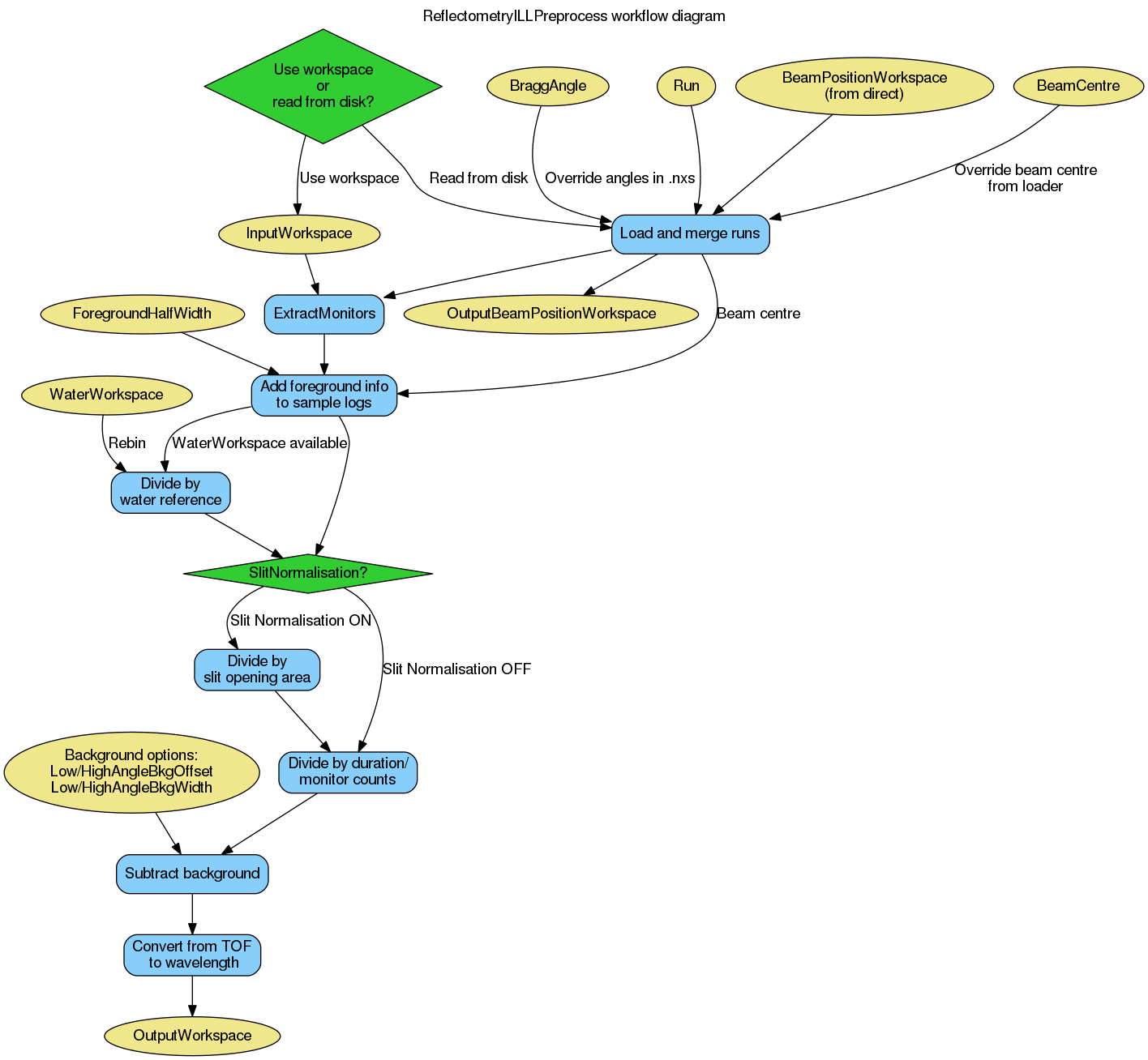Table of Contents
| Name | Direction | Type | Default | Description |
|---|---|---|---|---|
| Run | Input | list of str lists | A list of input run numbers/files. Allowed values: [‘nxs’] | |
| InputWorkspace | Input | MatrixWorkspace | An input workspace (units TOF) if no Run is specified. | |
| BeamPositionWorkspace | Input | TableWorkspace | A beam position table corresponding to InputWorkspace. | |
| BraggAngle | Input | number | Optional | A user-defined beam angle (unit degrees). |
| BeamCentre | Input | number | Optional | A workspace index corresponding to the beam centre. |
| OutputWorkspace | Output | MatrixWorkspace | Mandatory | The preprocessed output workspace (unit wavelength), single histogram. |
| SubalgorithmLogging | Input | string | Logging OFF | Enable or disable child algorithm logging. Allowed values: [‘Logging OFF’, ‘Logging ON’] |
| Cleanup | Input | string | Cleanup ON | Enable or disable intermediate workspace cleanup. Allowed values: [‘Cleanup ON’, ‘Cleanup OFF’] |
| DirectBeamPositionWorkspace | Input | TableWorkspace | A beam position table from a direct beam measurement. | |
| WaterWorkspace | Input | MatrixWorkspace | A (water) calibration workspace (unit TOF). | |
| SlitNormalisation | Input | string | Slit Normalisation OFF | Enable or disable slit normalisation. Allowed values: [‘Slit Normalisation OFF’, ‘Slit Normalisation ON’] |
| FluxNormalisation | Input | string | Normalise To Time | Neutron flux normalisation method. Allowed values: [‘Normalise To Time’, ‘Normalise To Monitor’, ‘Normalisation OFF’] |
| ForegroundHalfWidth | Input | int list | Number of foreground pixels at lower and higher angles from the centre pixel. | |
| FlatBackground | Input | string | Background Constant Fit | Flat background calculation method for background subtraction. Allowed values: [‘Background Constant Fit’, ‘Background Linear Fit’, ‘Background OFF’] |
| LowAngleBkgOffset | Input | number | 7 | Distance of flat background region towards smaller detector angles from the foreground centre, in pixels. |
| LowAngleBkgWidth | Input | number | 5 | Width of flat background region towards smaller detector angles from the foreground centre, in pixels. |
| HighAngleBkgOffset | Input | number | 7 | Distance of flat background region towards larger detector angles from the foreground centre, in pixels. |
| HighAngleBkgWidth | Input | number | 5 | Width of flat background region towards larger detector angles from the foreground centre, in pixels. |
| OutputBeamPositionWorkspace | Output | TableWorkspace | Output the beam position table. |
This algorithm is the first step in the ILL reflectometry reduction workflow. It:
The algorithm can be thought as an ‘advanced loader’, and should be used to load both direct beam and reflected beam measurements.
The OutputWorkspace can be further fed to ReflectometryILLSumForeground.
The workflow diagram below gives an overview of the algorithm:

The properties BeamCentre, BraggAngle and DirectBeamPositionWorkspace affect the pixel  angles. They map directly to the corresponding properties of LoadILLReflectometry. The BeamCentre property can be further used in determining the foreground pixels as discussed below.
angles. They map directly to the corresponding properties of LoadILLReflectometry. The BeamCentre property can be further used in determining the foreground pixels as discussed below.
Foreground is a set of pixels intensities of which will be summed in ReflectometryILLSumForeground. However, foreground needs to be defined already in this algorithm as the information is needed for the background pixels. The foreground pixel information is stored in the sample logs of OutputWorkspace under the entries starting with foreground..
Background, on the other hand, is a set of pixels which are be used for fitting a constant or linear background by CalculatePolynomialBackground.
The foreground pixels are defined by the foreground centre and ForegroundHalfWidth property. In normal use cases, the foreground center (workspace index) is taken from the fitting in LoadILLReflectometry. This can be overriden by giving the pixel as BeamCentre. Fractional values are rounded to nearest integer. The full process of deciding the foreground centre is as follows:
ForegroundHalfWidth is a list of one or two values. If a single value is given, then this number of pixels on both sides of the centre pixel are included in the foreground. For example, ForegroundHalfWidth=[3] means three pixel on both sides are included, making the foreground seven pixels wide in total. ForegroundHalfWidth=[0] means that only the centre pixel is included. When two values are given, then the foreground is asymmetric around the centre. For instance, ForegroundHalfWidth[2,5] indicates that two pixel at lower  and five pixels at higher
and five pixels at higher  are included in the foreground.
are included in the foreground.
LowAngleBkgWidth and HighAngleBkgWidth define the number of the background fitting pixels at low and high  . Either one or both widths can be defined. The distance between the background pixels and the foreground can in turn be given by LowAngleBkgOffset and HighAngleBkgOffset.
. Either one or both widths can be defined. The distance between the background pixels and the foreground can in turn be given by LowAngleBkgOffset and HighAngleBkgOffset.
The following figure exemplifies the foreground and background for the D17 instrument at ILL. Note, that in this particular case, the pixel indices increase with decreasing  .
.
(Source code, png, hires.png, pdf)

Example - Load direct and reflected beams
from directtools import SampleLogs
# Use same foreground and background settings for direct and reflected
# beams.
# Python dictionaries can be passed to algorithms as 'keyword arguments'.
settings = {
'ForegroundHalfWidth':[5],
'LowAngleBkgOffset': 10,
'LowAngleBkgWidth': 20,
'HighAngleBkgOffset': 10,
'HighAngleBkgWidth': 50
}
direct = ReflectometryILLPreprocess(
Run='ILL/D17/317369.nxs',
OutputBeamPositionWorkspace='direct_beam_pos', # For reflected angle calibration.
**settings
)
reflected = ReflectometryILLPreprocess(
Run='ILL/D17/317370.nxs',
DirectBeamPositionWorkspace='direct_beam_pos',
**settings
)
# Check foreground settings from sample logs
logs = SampleLogs(reflected)
print('Reflected beam centre: {}'.format(logs.foreground.centre_workspace_index))
# Half widths + centre pixel
width = logs.foreground.last_workspace_index - logs.foreground.first_workspace_index + 1
print('Foreground width: {}'.format(width))
Output:
Reflected beam centre: 202
Foreground width: 11
Categories: Algorithms | ILL\Reflectometry | Workflow\Reflectometry
Python: ReflectometryILLPreprocess.py (last modified: 2018-06-22)